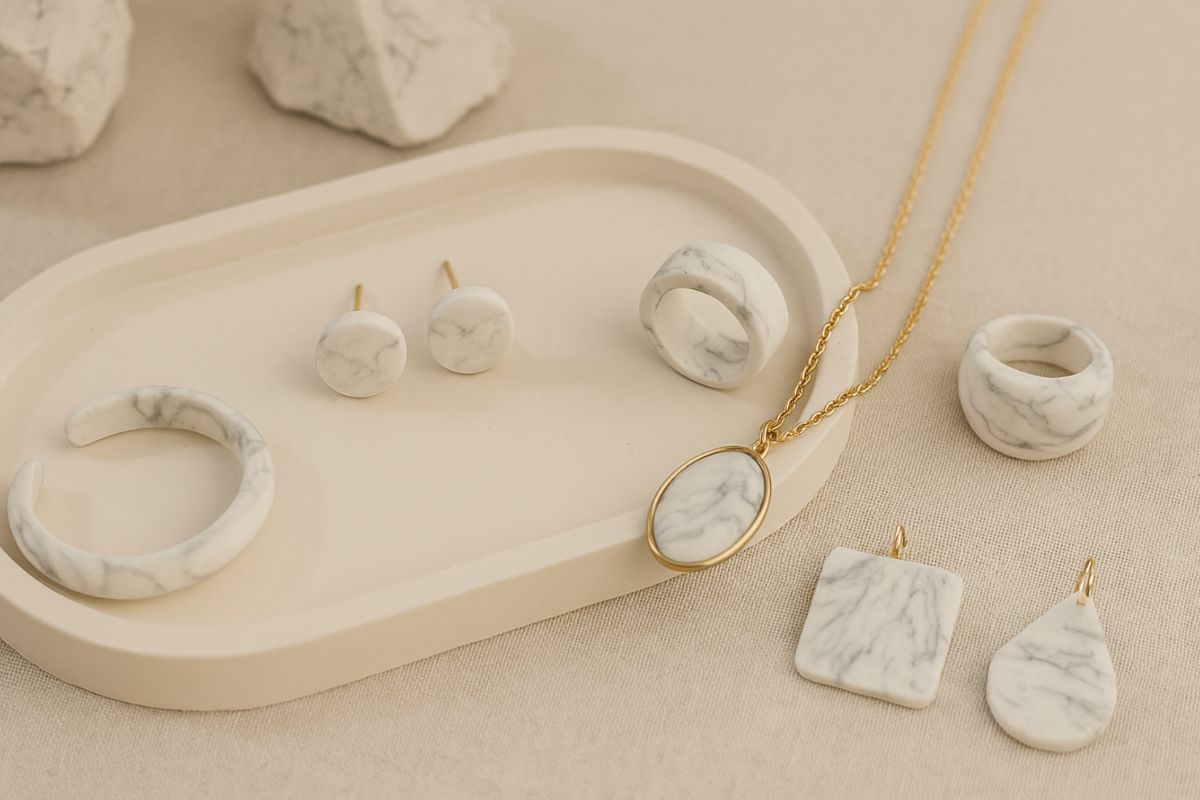

Marbled effect plaster jewelry
In the world of contemporary DIY, the search for innovative, sustainable, and visually striking materials has given rise to a new generation of handmade accessories. Among these, marbled plaster jewelry is emerging as a trend with a minimalist, artisanal, and refined appeal. In this article, we'll explore how to launch a line of jewelry made with Aqua Resin. , the ideal porcelain effect alpha plaster for this type of creation, and how to obtain the marbled effect using Aqua Pigment liquid pigments .
We'll discuss techniques, finishes, design, trends, packaging, and market positioning. Whether you're an artisan or an emerging artist, a creative looking for a new project, or a lover of personalized accessories, this guide will help you transform a simple material into a collection with great aesthetic and commercial potential.
Why choose plaster for your jewelry?
When you think of jewelry, metals, resins, and modeling clays come to mind. But there's another material that's winning over those more sensitive to design and sustainability: alfa gypsum. Specifically, Aqua Resin . It's a natural, toxic-free mineral powder, safe to use even indoors and easy to work with. Unlike common plaster, it has a fine, compact texture, similar to porcelain, perfect for small objects like earrings, pendants, rings, or brooches.
In addition to its aesthetic qualities, it is extremely versatile: it can be pigmented, decorated, sanded, drilled, glued, painted, and polished. When combined with Aqua Shield , it also becomes more resistant, shiny and waterproof, significantly increasing the durability of the accessories.
Aesthetics and style: why marble is so popular
The marbled effect is one of the most popular trends in design and craftsmanship. It evokes the natural beauty of stone, with irregular veining and unique hues. It's elegant yet modern, perfect for those seeking a minimalist accessory with personality. Thanks to the pigment-mixing technique, no two pieces will ever be identical, making each piece truly unique.
This style suits a soft palette – grays, whites, blush pinks, sage green – but can also be reinterpreted in a bold key with accents of black, midnight blue, or gold.
What you need to create your own jewelry
To get started, here are the basic supplies:
-
Aqua Shield (optional but recommended)
-
Silicone molds for jewelry
-
Wooden sticks or spatulas
-
Mixing glasses
-
Mini drill for drilling
-
Fine sandpaper
-
Hooks, earwires, bases for rings or pins
-
Jewelry glue
-
Protective varnish (optional)
Preparation of the basic mix
In a bowl or glass, mix 100 g of Aqua Resin with 50 g of water or Aqua Shield for a more resistant and shiny effect.
Separately, prepare small amounts of the same mixture and add drops of pigment: a white base, a gray base, a pink base, and a black base. Choose the colors according to the desired effect.
Technique for marbled effect
Pour the white base into the mold. Gradually add the other shades. Using a toothpick, gently stir the surface to create the veins. Don't overmix, or the color will blend too much.
Let it dry for at least an hour. Once the piece is unmolded, let it rest for at least 24 hours to dry completely. You can then finish the edges with sandpaper and drill holes with a mini drill.
To protect your jewelry, you can brush a thin layer of Aqua Shield , which will also give a slightly shiny effect to the surface.
Design ideas for your line
Here are some inspirations for building a coherent collection:
-
Geometric line
-
Romantic line
-
Botanical line
-
Minimal luxury line
You can also create matching sets: earrings + necklace + ring.
How to assemble your jewelry
Once the bases are ready, drilled, and finished, you can glue the metal components to the back. Use jewelry-grade glue or UV resin. Let dry thoroughly before packaging.
Packaging and branding
A handmade jewel deserves careful packaging:
-
Personalized cards
-
Cotton or linen sachets
-
Rigid boxes
-
Instruction labels
Care and maintenance of plaster jewelry
Always explain that your jewelry should be kept away from water and humidity. If you've used Aqua Shield,, the surface will be more protected.
How much does it cost to produce them and how much can you sell them for?
The cost of the materials is low, but the perceived value is high. A pair of marble-effect plaster earrings can sell for between 12 and 25 euros, depending on the design, attention to detail, and packaging.
Where to sell them
-
Craft markets
-
Etsy or personal e-commerce
-
Social media
-
Handmade events
-
Concept store
Conclusion
Create a line of marbled plaster jewelry with Aqua ResinIt's a creative, ethical, and accessible project. With a little practice and a lot of care, you can build a collection that speaks to you and will captivate those seeking something authentic, light, and poetic to wear every day.